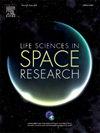Shared mechanisms in neuromyelitis optica spectrum disorder and spaceflight-associated neuro-ocular syndrome: Insights into central nervous system fluid dynamics, glymphatic function, and astrocyte dysregulation
IF 2.8
3区 生物学
Q2 ASTRONOMY & ASTROPHYSICS
引用次数: 0
Abstract
Spaceflight-Associated Neuro-ocular Syndrome (SANS) and Neuromyelitis Optica Spectrum Disorder (NMOSD) represent distinct neurological challenges with intriguing parallels in their disruption of central nervous system (CNS) fluid dynamics and the clinical neuro-ophthalmic manifestations. SANS, affecting astronauts during prolonged spaceflight, is characterized by optic disc edema, globe flattening, and vision changes resulting from microgravity-induced cephalad fluid shifts. NMOSD, an autoimmune astrocytopathy, is driven by aquaporin-4 (AQP4) autoantibodies that compromise astrocytic water regulation and blood-brain barrier integrity. This review explores the shared pathophysiological processes of SANS and NMOSD, focusing on AQP4 dysregulation, cerebrospinal fluid dynamics, and neuroinflammatory mechanisms. We examine advanced imaging techniques, biomarkers, and molecular pathways relevant to both conditions, highlighting how insights from NMOSD research might inform our understanding of SANS. The role of the glymphatic system and its potential impairment in both disorders is discussed as a novel perspective on CNS waste clearance. By identifying parallels between SANS and NMOSD, we aim to provide a framework for translating findings between space medicine and terrestrial neuroimmunology. This comparative analysis may drive innovative therapeutic approaches for conditions involving CNS fluid dysregulation, ultimately advancing both astronaut health and patient care for NMOSD and related disorders.
视神经脊髓炎频谱障碍和航天相关神经眼综合征的共同机制:对中枢神经系统流体动力学、淋巴功能和星形胶质细胞失调的见解
航天飞行相关的神经-眼综合征(SANS)和视神经脊髓炎光谱障碍(NMOSD)代表了不同的神经系统挑战,它们在中枢神经系统(CNS)流体动力学破坏和临床神经-眼表现方面具有有趣的相似之处。SANS在长时间的太空飞行中影响宇航员,其特征是视盘水肿、球体变平和由微重力引起的头部液体移位引起的视力变化。NMOSD是一种自身免疫性星形细胞病,由水通道蛋白-4 (AQP4)自身抗体驱动,该抗体破坏星形细胞水分调节和血脑屏障的完整性。本文探讨了SANS和NMOSD的共同病理生理过程,重点关注AQP4失调、脑脊液动力学和神经炎症机制。我们研究了与这两种情况相关的先进成像技术、生物标志物和分子途径,强调了NMOSD研究的见解如何有助于我们对SANS的理解。在这两种疾病中,淋巴系统的作用及其潜在的损害被讨论为中枢神经系统废物清除的新视角。通过确定SANS和NMOSD之间的相似之处,我们的目标是为空间医学和陆地神经免疫学之间的研究结果提供一个框架。这种比较分析可能会推动涉及中枢神经系统液体失调的疾病的创新治疗方法,最终促进宇航员的健康和NMOSD及相关疾病的患者护理。
本文章由计算机程序翻译,如有差异,请以英文原文为准。
求助全文
约1分钟内获得全文
求助全文
来源期刊

Life Sciences in Space Research
Agricultural and Biological Sciences-Agricultural and Biological Sciences (miscellaneous)
CiteScore
5.30
自引率
8.00%
发文量
69
期刊介绍:
Life Sciences in Space Research publishes high quality original research and review articles in areas previously covered by the Life Sciences section of COSPAR''s other society journal Advances in Space Research.
Life Sciences in Space Research features an editorial team of top scientists in the space radiation field and guarantees a fast turnaround time from submission to editorial decision.
 求助内容:
求助内容: 应助结果提醒方式:
应助结果提醒方式:


